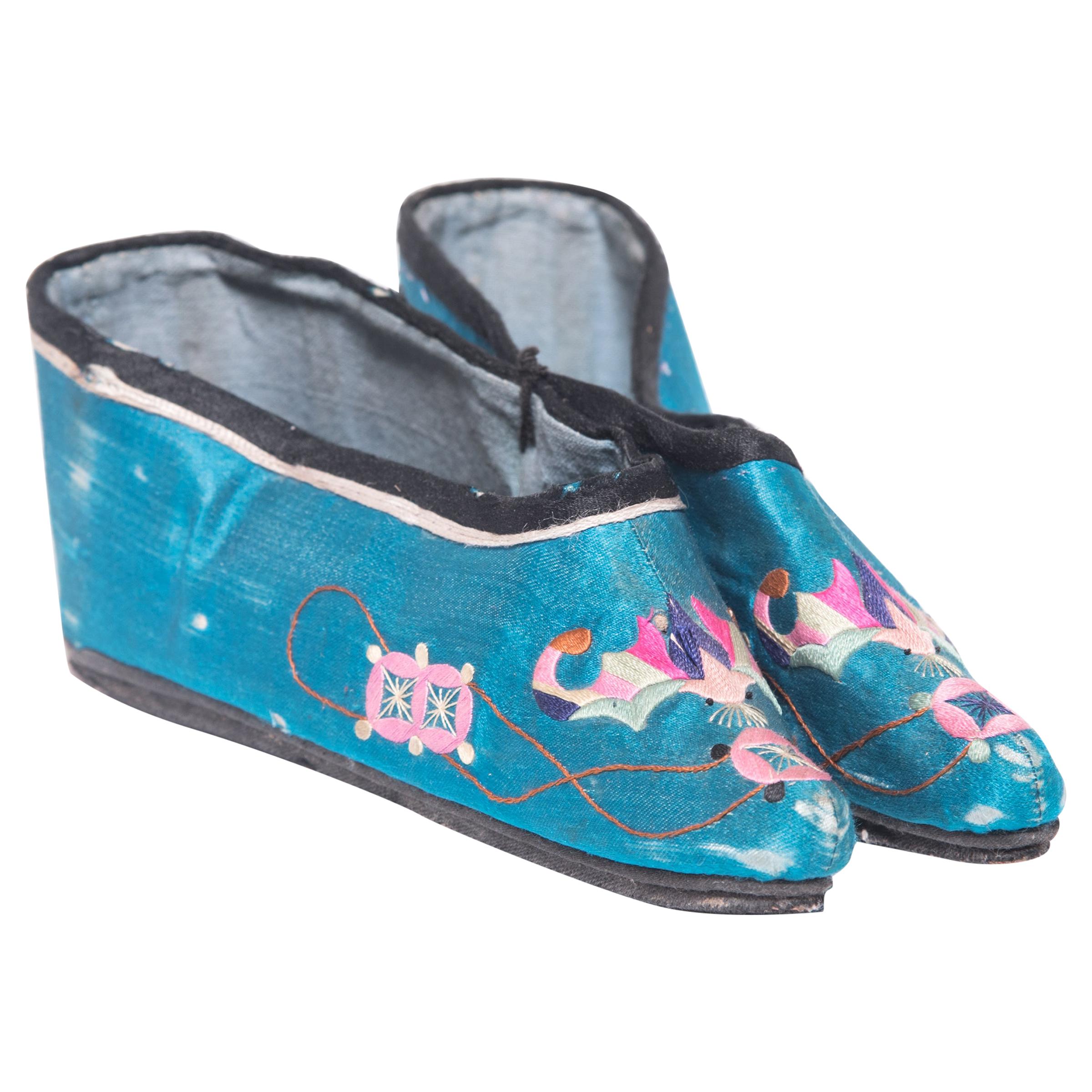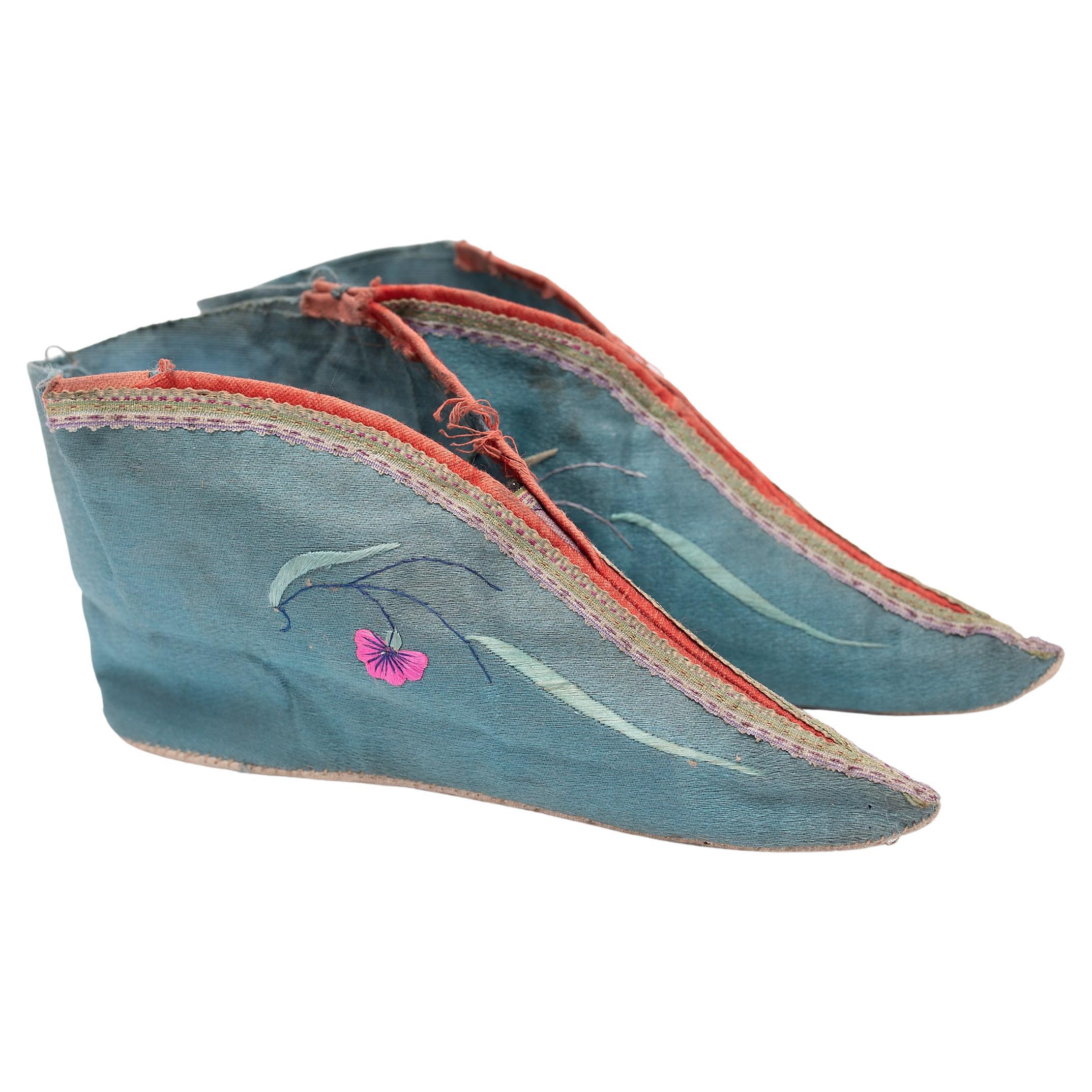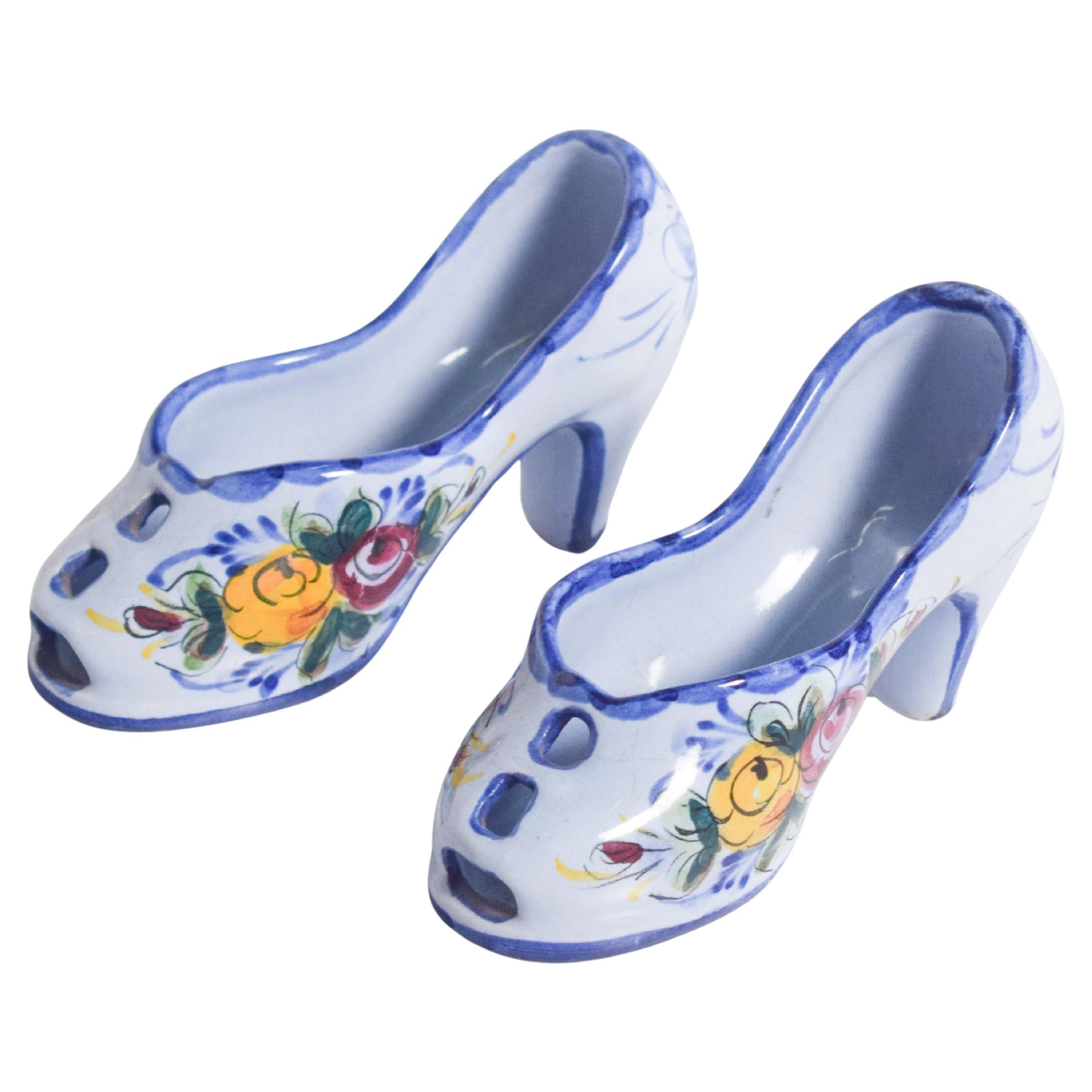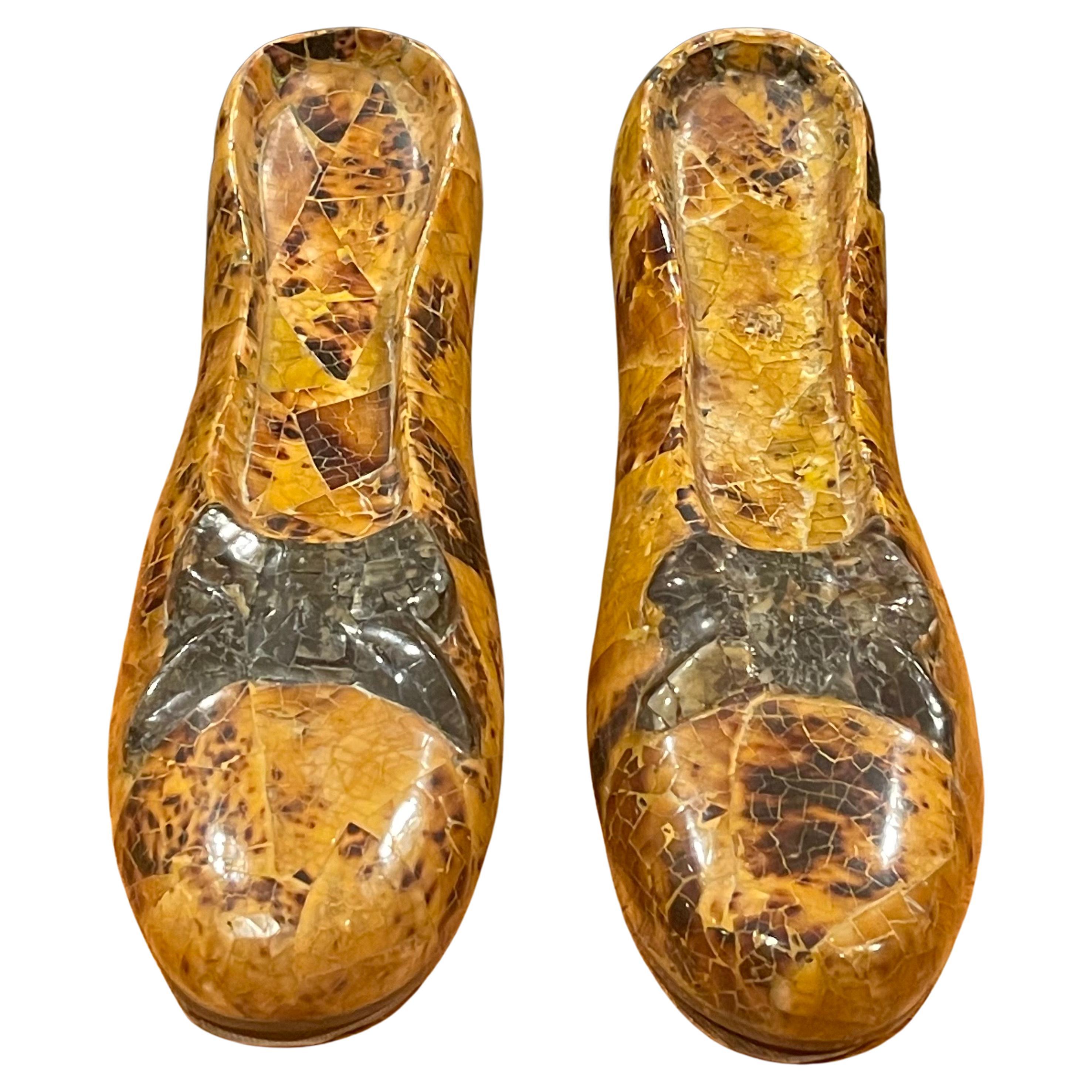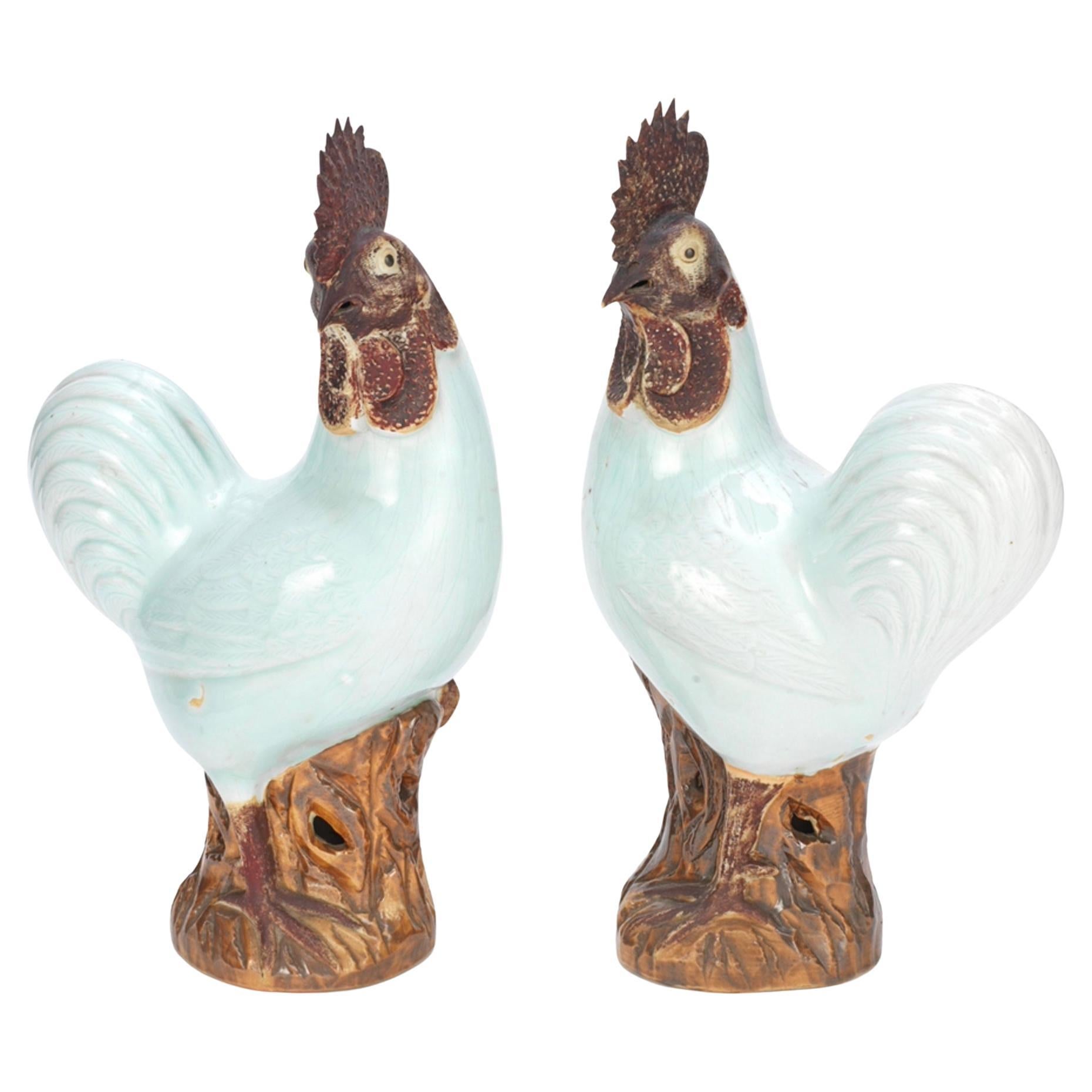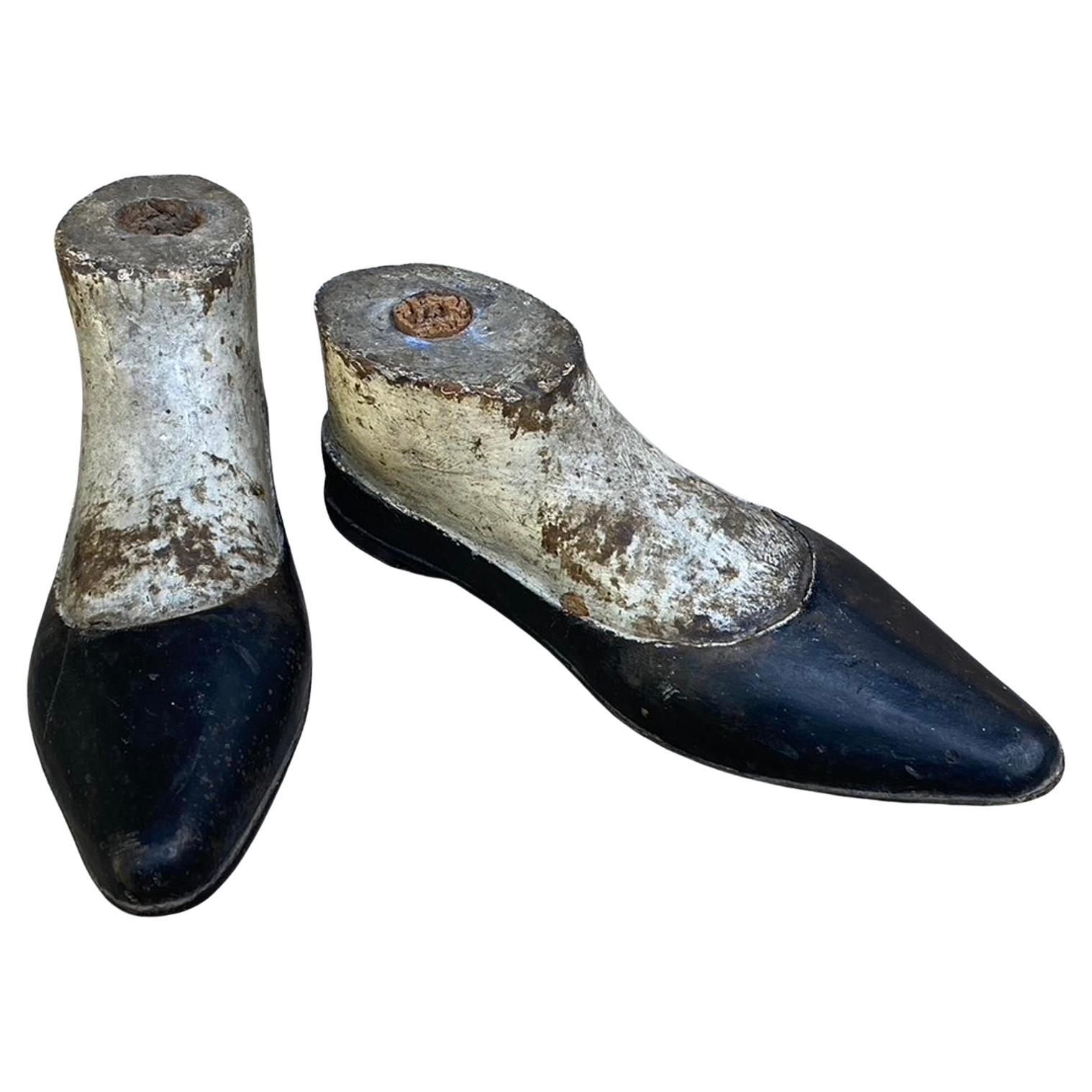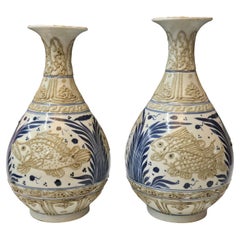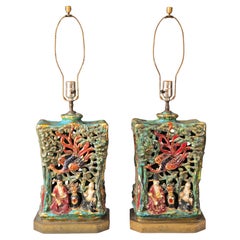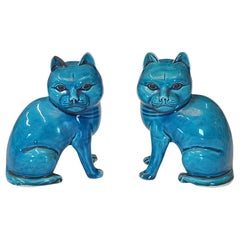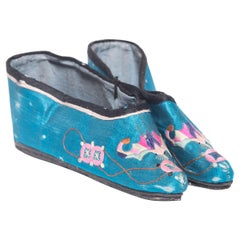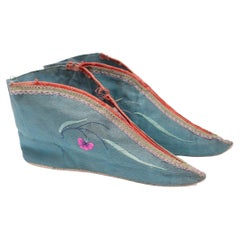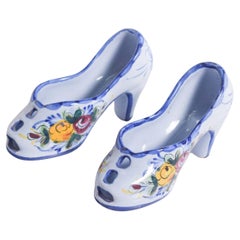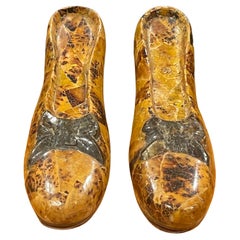Items Similar to Pair of Sancai Glazed Tang Dynasty Ceramic Slippers
Video Loading
Want more images or videos?
Request additional images or videos from the seller
1 of 13
Pair of Sancai Glazed Tang Dynasty Ceramic Slippers
$660
£501.56
€577.25
CA$944.49
A$1,037.73
CHF 535.15
MX$12,433.03
NOK 6,794.75
SEK 6,376.60
DKK 4,311.27
About the Item
A remarkably rare and unusual pair of sancai-glazed slippers dating from the Tang Dynasty (618–907 CE). These were likely created as funerary mingqi—tomb objects made to accompany the deceased into the afterlife—but their distinctively sculpted form and rich glaze elevate them well beyond typical tomb wares.
Styled to resemble the flower brocade slippers worn by elite women during the Tang era, the ceramics show a masterful interpretation of textile form in clay, complete with upturned toes and elegant silhouettes. Their profile closely mirrors examples found in Asitana, Turfan, in the Xinjiang Uygur Autonomous Region (see figure 178 in 5000 Years of Chinese Costume), a key Silk Road site where Chinese, Persian, and Central Asian aesthetics commingled.
These toe-up-warped slippers were not just fashion statements—they held symbolic value within Tang society. Footwear in ancient China was a marker of status, refinement, and ritual hierarchy. The exaggerated toe, in particular, had both practical and ceremonial connotations, reflecting Central Asian influences popular at the time and the aesthetic exuberance that defined Tang material culture.
Executed in **classic Tang sancai glaze—earthy greens, ochres, and creamy whites—**the surface features that distinctive semi-translucent pooling and flow, a signature of this era’s low-fired lead glazes. The subtle warping of the form adds to their charm and authenticity.
Today, sancai pieces—especially textile- or object-representative forms like these—are increasingly valued by collectors for their rarity and historical importance. Objects like these offer not only a glimpse into Tang fashion, but also into ritual practices, Silk Road exchange, and Tang ceramic innovation.
- Dimensions:Height: 3.25 in (8.26 cm)Width: 9 in (22.86 cm)Depth: 3 in (7.62 cm)
- Style:Tang (Of the Period)
- Materials and Techniques:
- Place of Origin:
- Period:
- Date of Manufacture:618-907
- Condition:Repaired: Old repair on one shoe. Wear consistent with age and use. Minor losses. Minor structural damages. Minor fading. Shoes both have issues one has an older repaired break and one has a hairline crack visible. Price reflects condition and rarity.
- Seller Location:Kilmarnock, VA
- Reference Number:1stDibs: LU883043830492
About the Seller
4.8
Vetted Professional Seller
Every seller passes strict standards for authenticity and reliability
Established in 2004
1stDibs seller since 2009
170 sales on 1stDibs
Typical response time: 1 hour
- ShippingRetrieving quote...Shipping from: Kilmarnock, VA
- Return Policy
Authenticity Guarantee
In the unlikely event there’s an issue with an item’s authenticity, contact us within 1 year for a full refund. DetailsMoney-Back Guarantee
If your item is not as described, is damaged in transit, or does not arrive, contact us within 7 days for a full refund. Details24-Hour Cancellation
You have a 24-hour grace period in which to reconsider your purchase, with no questions asked.Vetted Professional Sellers
Our world-class sellers must adhere to strict standards for service and quality, maintaining the integrity of our listings.Price-Match Guarantee
If you find that a seller listed the same item for a lower price elsewhere, we’ll match it.Trusted Global Delivery
Our best-in-class carrier network provides specialized shipping options worldwide, including custom delivery.More From This Seller
View AllNear Pair Yuhuchun Shaped Vases
Located in Kilmarnock, VA
striking and sculptural pair of hand-thrown vases in the classic Yuhuchun shape, each decorated with raised, applied fish in dynamic relief. Rendered in underglaze cobalt blue with ...
Category
20th Century Chinese Vases
Materials
Porcelain
$2,800 / set
Pair of Chinoiserie Majolica Lamps by Eugenio Pattarino
By Eugenio Pattarino
Located in Kilmarnock, VA
Beautiful Set of Chinoiserie Majolica Lamps by Prof. Eugenio Pattarino, Florence, Late 1940s
A captivating pair of Chinoiserie-inspired majolica lamps, crafted in the late 1940s by ...
Category
Vintage 1940s Italian Hollywood Regency Table Lamps
Materials
Brass
Vintage Pair of Figural Abstract Studio Pottery Vases
Located in Kilmarnock, VA
A striking pair of hand-sculpted earthenware vases, each rendered in an abstracted figural form that blurs the line between vessel and sculpture. Thrown on the wheel and then masterf...
Category
Vintage 1960s American Organic Modern Vases
Materials
Earthenware
Unusual Chinese Turquoise Pair of Large Headed Cat Figurines
Located in Kilmarnock, VA
A striking and unusual pair of Chinese cats from the 1930s, glazed in a vibrant turquoise color that captures attention with its rich, luminous quality. Wh...
Category
Early 20th Century Ceramics
Materials
Porcelain
Pair of 1960s Italian Sculptural Vases
Located in Kilmarnock, VA
A striking pair of mid-century ceramic vases by F.lli Marchi, Italy, circa 1960. Each piece features an organic, biomorphic silhouette with dynamic surface texture and presence. The ...
Category
Vintage 1960s Italian Mid-Century Modern Vases
Materials
Gold, Enamel
$960 / set
Pair of Vibrant Yellow Italian Majolica Tang Dynasty Horses
Located in Kilmarnock, VA
A dazzling pair of Italian majolica tabletop sculptures inspired by Tang Dynasty Chinese horses, reimagined in a brilliant chrome yellow glaze that transforms these traditional forms...
Category
Vintage 1950s Italian Hollywood Regency Animal Sculptures
Materials
Earthenware
You May Also Like
Pair Chinese Double Luck Lotus Slippers, c. 1850
Located in Chicago, IL
These pointed silk slippers are beautifully embroidered with colorful bats and golden coins, symbols of happiness and good luck, and were shaped to resemble a lotus bud to enhance one's bound feet. A practice that began in the Tang dynasty and reached the height of its popularity during the Qing dynasty, foot binding was a painful process intended to make a woman's feet as small as possible by restricting bone growth from an early age. The smaller the feet the more attractive and erotic they were, giving elite women a mark of elegance and a distinctive, albeit tortured, gait of small, light steps. These beautifully preserved lotus slippers...
Category
Antique Mid-19th Century Chinese Qing Historical Memorabilia
Materials
Fabric, Silk
Pair of Chinese Silk Lotus Slippers, c. 1850
Located in Chicago, IL
These dainty, pointed slippers, made of blue silk and embroidered with pink flowers, were shaped to resemble a lotus bud and enhanced the diminutive shape of bound feet. A practice that began in the Tang dynasty and reached the height of its popularity in the Qing dynasty, foot binding was a painful process intended to make a woman's feet as small as possible by restricting bone growth from an early age. The smaller the feet the more attractive and erotic they were, giving elite women a mark of elegance and a distinctive - albeit tortured - gait of small, light steps. These embroidered silk lotus slippers...
Category
Antique Mid-19th Century Chinese Qing Textiles
Materials
Cotton, Silk
Pair of Portuguese Pottery Shoes, Alcobaça
Located in Lisboa, Lisboa
This charming pair of Portuguese pottery shoes, crafted in the renowned Alcobaça – Vestal style, showcases the region’s signature artisanal beauty. Made from blue-glazed pottery, the...
Category
Mid-20th Century Portuguese Mid-Century Modern Figurative Sculptures
Materials
Pottery
$285 Sale Price / set
40% Off
Pair of Tessellated Stone Decorative Shoes by Maitland Smith
By Maitland Smith
Located in San Diego, CA
Pair of tessellated stone decorative shoes by Maitland Smith, circa 1970s. Made in the Philippines; each shoe is 3"W x 10"D x 4"H. #1948.
Category
Late 20th Century Philippine Hollywood Regency Figurative Sculptures
Materials
Stone
$280 Sale Price
20% Off
Pair of Early 19th Century Chinese Antique Porcelain Cockerels
Located in London, GB
A fine pair of late 18th early 19th century Chinese Export porcelain models of cockerels, each standing on coloured rockwork base, the bodies with a pale celadon glaze and fine feathering...
Category
Antique Early 19th Century Chinese Ceramics
Materials
Porcelain
Pair of Antique Santa Virgin Shoes
Located in Los Angeles, CA
Pair of polychrome wooden shoes, originally attached to a large Santa Virgen figure from Guatemala. The shoes are finely carved with pointed toes and painted black, with remnants whi...
Category
Antique Early 19th Century Guatemalan Spanish Colonial Sculptures and Ca...
Materials
Wood
